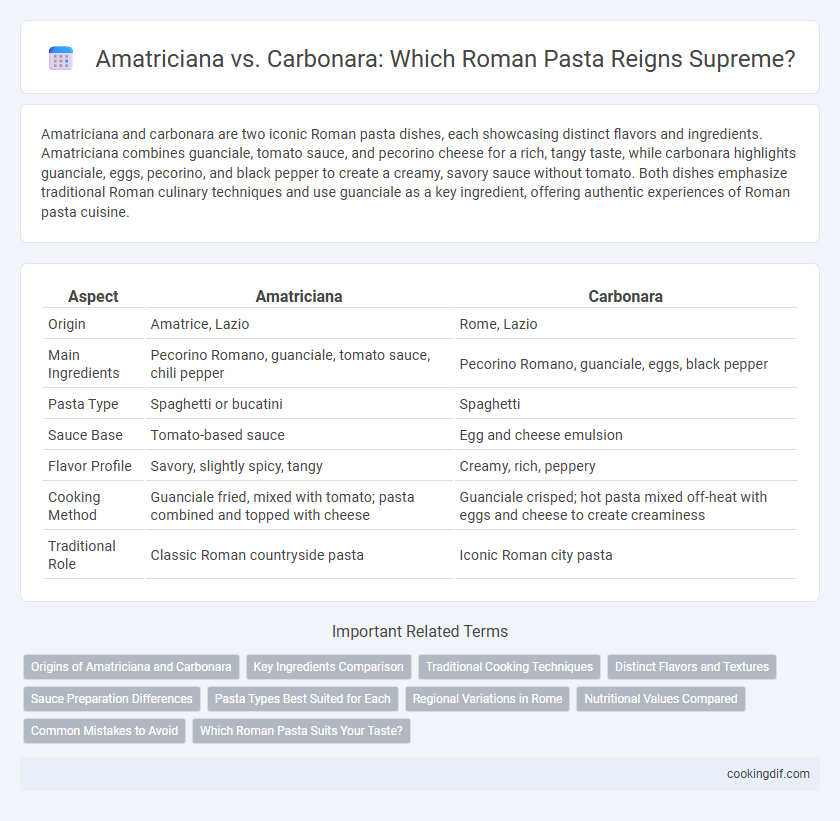Amatriciana and carbonara are two iconic Roman pasta dishes, each showcasing distinct flavors and ingredients. Amatriciana combines guanciale, tomato sauce, and pecorino cheese for a rich, tangy taste, while carbonara highlights guanciale, eggs, pecorino, and black pepper to create a creamy, savory sauce without tomato. Both dishes emphasize traditional Roman culinary techniques and use guanciale as a key ingredient, offering authentic experiences of Roman pasta cuisine.
Table of Comparison
| Aspect | Amatriciana | Carbonara |
|---|---|---|
| Origin | Amatrice, Lazio | Rome, Lazio |
| Main Ingredients | Pecorino Romano, guanciale, tomato sauce, chili pepper | Pecorino Romano, guanciale, eggs, black pepper |
| Pasta Type | Spaghetti or bucatini | Spaghetti |
| Sauce Base | Tomato-based sauce | Egg and cheese emulsion |
| Flavor Profile | Savory, slightly spicy, tangy | Creamy, rich, peppery |
| Cooking Method | Guanciale fried, mixed with tomato; pasta combined and topped with cheese | Guanciale crisped; hot pasta mixed off-heat with eggs and cheese to create creaminess |
| Traditional Role | Classic Roman countryside pasta | Iconic Roman city pasta |
Origins of Amatriciana and Carbonara
Amatriciana pasta originates from the town of Amatrice in the Lazio region, traditionally made with guanciale, tomato sauce, pecorino cheese, and chili peppers, reflecting its rural Roman heritage. Carbonara, rooted in mid-20th century Rome, is characterized by its creamy sauce crafted from eggs, pecorino romano, guanciale, and black pepper, embodying post-war Roman culinary innovation. Both dishes represent iconic Roman pasta styles, showcasing distinct ingredients and historical influences that highlight regional Italian gastronomy.
Key Ingredients Comparison
Amatriciana features guanciale, pecorino romano cheese, and a tomato-based sauce, creating a rich, tangy flavor profile. Carbonara relies on guanciale, pecorino romano, eggs, and black pepper, resulting in a creamy, savory texture without tomato. Both iconic Roman pastas highlight guanciale and pecorino romano but differ mainly in the presence of tomato for amatriciana and eggs for carbonara.
Traditional Cooking Techniques
Amatriciana and Carbonara represent two iconic Roman pasta dishes distinguished by their traditional cooking techniques: Amatriciana features guanciale slowly rendered with tomato sauce and pecorino Romano cheese, while Carbonara relies on a careful emulsification of raw eggs, guanciale, pecorino Romano, and black pepper to create a creamy texture without cream. The guanciale in both dishes is crisped to enhance flavor, but Amatriciana's slow simmering with tomato contrasts Carbonara's rapid sauce preparation off the heat to prevent scrambling the eggs. Mastery of timing and temperature control is essential to preserve the authentic taste and texture characteristic of these Roman culinary classics.
Distinct Flavors and Textures
Amatriciana features a rich, tangy tomato sauce combined with guanciale, creating a savory and slightly spicy flavor profile that contrasts with the creamy, smooth texture of carbonara's egg-based sauce enriched with Pecorino Romano cheese and crisp guanciale. The robust acidity of tomatoes in Amatriciana provides a vibrant complexity, while carbonara emphasizes a delicate balance of umami and creaminess without any tomato. Both dishes highlight guanciale but deliver distinctly different taste experiences through their sauces and textures, essential to authentic Roman pasta traditions.
Sauce Preparation Differences
Amatriciana sauce is prepared with guanciale, tomatoes, pecorino romano, and chili flakes, which creates a tangy and slightly spicy flavor profile. Carbonara sauce combines guanciale, eggs, pecorino romano, and black pepper, resulting in a creamy, rich texture without any tomato. These distinct ingredient bases highlight the fundamental difference in how traditional Roman pasta sauces are crafted and experienced.
Pasta Types Best Suited for Each
Amatriciana traditionally features bucatini pasta, whose hollow center captures the rich tomato and guanciale sauce perfectly, ensuring each bite is flavorful and balanced. Carbonara is best paired with spaghetti or rigatoni, which absorb the creamy eggs and pecorino cheese mixture, creating a smooth texture that complements the pancetta's salty crispiness. Choosing the right pasta type enhances the authenticity and taste profile unique to these iconic Roman dishes.
Regional Variations in Rome
Amatriciana and Carbonara are iconic Roman pasta dishes that showcase distinct regional variations through their ingredients and preparation techniques. Amatriciana originates from the town of Amatrice near Rome, featuring guanciale, tomato sauce, pecorino Romano, and chili flakes, while Carbonara relies on guanciale, eggs, pecorino Romano, and black pepper without tomato. These differences highlight the diverse culinary traditions within Rome's surrounding areas, reflecting cultural preferences in seasoning and texture for authentic Roman cuisine.
Nutritional Values Compared
Amatriciana and Carbonara, two iconic Roman pasta dishes, differ significantly in nutritional composition. Amatriciana typically features tomato sauce, guanciale, and pecorino cheese, providing a rich source of proteins and healthy fats but also higher sodium and calorie content due to cured meat. Carbonara combines eggs, pecorino cheese, guanciale, and pasta, offering a higher protein content and essential vitamins from eggs but with increased saturated fat and cholesterol levels, making it essential to consider individual dietary needs when choosing between them.
Common Mistakes to Avoid
Common mistakes to avoid when making Roman pasta dishes like Amatriciana and Carbonara include using cream in Carbonara, which is not traditional and dilutes the authentic flavor. Another frequent error is substituting guanciale with pancetta or bacon, as guanciale's unique texture and taste are essential to both recipes. Overcooking the pasta or the sauce can ruin the delicate balance of flavors and textures characteristic of these iconic Roman dishes.
Which Roman Pasta Suits Your Taste?
Amatriciana features a robust combination of guanciale, tomato sauce, and pecorino romano, delivering a tangy and savory flavor perfect for those who enjoy a rich, slightly spicy pasta. Carbonara offers a creamy texture with eggs, guanciale, pecorino romano, and black pepper, suited for lovers of smooth, silky dishes with a subtle peppery kick. Choosing between these iconic Roman pastas depends on your preference for either a tomato-based zest or a creamy, egg-rich experience.
Amatriciana vs carbonara for Roman pasta Infographic

 cookingdif.com
cookingdif.com